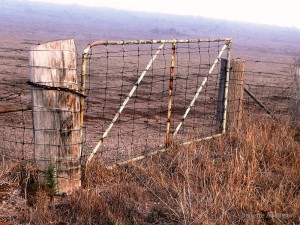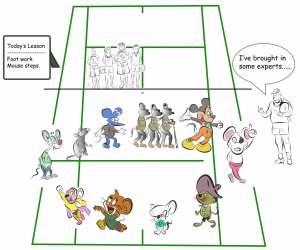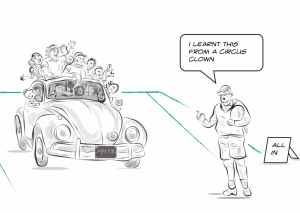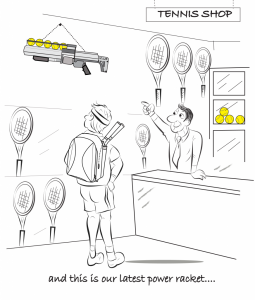Rustiness
Are you swinging like a rusty gate ?
For the tennis player who is trying to move up the club ladder and/or make changes to a stroke, taking a long break from tennis is not a good idea.
However some times a break from tennis is unavoidable; you may have sustained an injury, you may have had a medical problem, you may have burnt out and need a mental rest (see my book Tennis with Passion on the psychological side of tennis) or it may be the long holiday break closes down all group activities at the tennis club (group lessons, social tennis, fixtures, tournaments).
In the southern hemisphere this long summer school holiday coincides with Christmas. It also coincides with the Summer of Tennis in Australia where there are several major lead-up tournaments finishing with the Australian Open. So there is plenty of top grade tennis being presented on TV.
Whatever the reason, there is a possibility that you will be one of the people not playing for four weeks, or even 6-8 weeks. And also probably you would have watched several matches involving the pros which would probably have fired you up and got you keen to get back on the tennis court and try out all those new things you have noticed the pros doing.
AND if you are one of those players who have not picked up your racket for many weeks……when you do eventually get back on the court Rustiness would have set in.
Some players handle Rustiness quite well, and patiently and slowly wait for their old form to come back. Others ignore Rustiness and go straight into a 100% copy of the pros…..and wonder why every ball goes out.
For some people , regarding Rustiness, they find that their body (strokes, timing, body movements) get knocked around only a small amount. Some others find that their body gets knocked around a massive amount. This latter group look like they have never played before and cannot seem to get organised with the ball at all. I have seen some very good players come back from a long break from tennis, and play and look like a D grade club player.
However, I have found that the formula is the same…..the formula of how to get back to your old form as quickly as possible. So it does not matter to which degree of Rustiness you are being hit with, what matters is that you realize that some form of Rustiness is in your game.
For me I have found it to be incredibly helpful to 1. Be aware of Rustiness and 2. Know everything about the items which make up Rustiness.
So lets start with that.
The worst cases seem to be the combination of a long lay off and recovery from an illness which involved bed rest.
Some of you know how I love to prioritise….well on this subject I am not sure which comes first, there seem to be quite a few critical items. And lack of just one critical item immediately kills good performance. Just like lack of ball watching or concentration kills the strokes.
Having said the above, I think I will make Habit the top priority.
When you do not play or practice you get out of the habit of making many correct moves.
If you have a stoke with an old incorrect habit which was then partially improved and corrected, I am willing to bet that whilst Rustiness is a factor you will revert to your old stroke….your old habit. That is why regular practice is so important if you wish to make new strokes (new habits).
Nearly every club player I have seen, in coming back from a lay off, can do reasonably well with any of their strong strokes, except for their weaker strokes which usually totally collapse. An interesting item is that when they are in top form their weak stroke almost seems to be ok. That is because when they are in form they are compensating correctly. This happens only when they are playing frequently. Of course that weakness is truly there and always there, but may not show up until under maximum pressure. Maximum pressure may come from a better/stronger opponent or from the importance of a particular match (perhaps the semi final of the annual club championships ).
The following items are the ones or some of the ones which most likely will have snuck in below your radar of consciousness. You may be aware of some of them ?????, however in my experience the average player is usually not fully aware of specific items giving trouble and seems so often to walk around in a daze, puzzled by their non functioning body and mumbling things like “ gee, nothing feels right” or “my timing is off” or “I can’t believe I am playing so badly” or “ I feel like I have not played for a year” or “I am playing worse than a beginner”.
Footwork
One easily gets out of the habit of using professional footwork. A majority of our movement for tennis is in the two to four meter range, thus do we need long strides ? No, we are not in the middle of the hundred meter sprint in the Olympics. The best animal for us to copy is the mouse. See the sketch below. This animal makes many small steps, is light on its feet and makes hardly any noise……exactly what a tennis player needs. My first lesson in this area took place whilst I was playing a tournament in Cairo, Egypt. It was mid-week and incredibly quiet and peaceful. I was watching my friend Donald Dell play his match and I was sitting courtside. Donald later became a winning captain of the USA Davis Cup team. This tournament was on clay. It suddenly occurred to me that if I studied Donald’s opponent during a rally, I was not hearing any noise (footwork noise) from Donald’s end. I then studied Donald as he played out the points. I had previously watched him play many matches, but never registered on this point. The point being that Donald was making almost no noise with his feet in a normal rally. He was so light on his feet, almost floating over the court surface. Of course in those days I never envisaged myself becoming a tennis coach so I simply said to myself “oh, that’s the way Donald plays” ….and left it at that. Luckily for me that moment, that picture of him noiselessly gliding around the court stuck in my memory, so that years later when I was studying everything about the game of tennis and footwork I was able to use this as a perfect example. To this day I have not seen anyone as light as Donald on their feet.
So back to you….has Rustiness set into your footwork ? Not sure? Then always remember, if you are in doubt it is always better to do too much footwork than not enough. Can you do too much footwork ?
Well my answer to you would be this……….until you win Wimbledon I think it best that you assume that you cannot do too much footwork.
Poor footwork includes the feeling that your feet are made of lead !
So, good luck being a mouse !
Ball watching
This is a bit similar to our footwork problem. Can you ever do ball watching that is too perfect ? No way !!
My old coach constantly would yell at us …. “Glue your eyes on the ball !!”. See sketch below.
Good ball watching requires constantly refocusing the eyes; which requires muscle movement. Muscles get lazy. Muscles get into bad habits. Your best bet is this…..have not played for a whilst ? Almost certainly you will have lost some of your good ball watching habits.
Have not played much lately??….then assume the worst, in which case you need to immediately do some repair work on your ball watching. Are you focused on the ball properly ? Are you seeing the spin of the ball ? Or are you using only peripheral vision ?
Actual movement of the body including arm swing.
Rustiness and nervousness/choking are almost the same thing to the physical body. The cause is different but the result is pretty much the same and typical symptoms are the feet/legs feeling like lead and the arms feeling stiff and not free.
Your best bet is to assume the worst, and then hop in and pump some energy into those limbs. Make them move, force them to move.
Reaction time (late)
Not playing means you drop out of the habit of doing things in the best possible manner. Besides the feet and the arms feeling heavy and not free you will probably not be watching the ball properly. Your feet and arms will be moving slower than normal , your eyes will not be giving you any advanced warning with the result…..you will be late. See the sketch below.
This will be happening as sure as the sun comes up tomorrow. Your best bet is to be aware of these items, assume it is all going wrong and……put a bomb under yourself. You need to get going earlier, you need to start making decisions earlier and you need to get out of the starting blocks earlier.
Do not forget to light the bomb !!!
Mechanics of each stroke.
You would need to check on individual mechanics of each stroke. If you are advanced enough you would pay particular attention to any weakness you know of or any new item you have been working on to improve a particular stroke.
It may be your serve. So you would first make sure you are getting a clean hit. Then make sure your action is smooth and not rushed or jerky. Then look for your specific items of possible weakness. Is the toss high enough ? Is the toss in the correct place ? Are you following through enough ? If it is a first serve, is the toss far enough in front ? If it is a second serve, are you getting enough spin on the ball ?
And perhaps even…..are you losing power ? If so, why ? And lastly, is your serve effortless and efficient ?
If you do all of the above, your old serve should come back quickly!
Recovery
Are you recovering after your last shot ? Back to the center ? Immediately after hitting? And, are you hustling after your last hit? (Like your life depends on it ?……….and your tennis life does depend on it if you are playing a good player).
Check your recovery ? Are you saying “what’s the point, I do not even know if my ball is going in “.
It is all up to you. Do you want to be professional about your tennis ? Do you want to be All In ?? See my book Tennis with Passion where I explain what All In means. See the sketch below. Then learn to recover in a professional manner.
Check if you are hitting too hard ?
The half of the tennis players in the world who derive immense pleasure from hitting the ball at full power will almost certainly be hitting the ball too hard after an extended layoff from their regular tennis schedule. See sketch below.
For these people dealing with Rustiness I use the jet fighter plane story. In this story the previous plane crashed. You have been given the task of taking a new plane for a test flight. Do you immediately fly it at full speed and try the most demanding manoeuvres ? No. You take it step by step and all the time checking on things. Are the wings starting to vibrate? Is the plane not responding? If your checks are positive you increase the speed and difficulty a small amount….and check again. At the first sign of trouble you return to base……if you value your life. Your tennis life involves winning a match. If you cannot hit the ball in, hit softer and either then fix other problems OR accept that that will be the best you can do on that day. Always live to fight another day !
Check to see if you are aiming too close to the lines.
So many players dream of playing like the pros and thus aim too close to the lines. I find that many times this is an unconscious choice by the player, they are many times not even aware they are doing that. If you are rusty you will lose some control of the ball, so aiming close to the lines at this stage is simply crazy. You need to hit the ball in, you need to get some consistency going in order to have your best chance of quickly eliminating your Rustiness. You should already know what your Spray Factor is. For example if your spray factor is 2.8 meters…..you need to aim 3 meters inside the sideline….if you want to guarantee your ball stays in the court. Do you know where that is on the court ? No ?? Then you need to walk it off, and if in a practice session I would advise you to put a marker down at that 3 meter mark. That marker will remind you of where your aiming spot needs to be.
As you eliminate your Rustiness you can then shift your marker closer to the sideline.
The sketch below will help you determine where you should aim. Remember, approximately, if your spray factor is around 3 meters you will need to aim in the middle of the Red Circle ……if you want to guarantee your ball stays in !!!!!
(It will be hard to beat a good player doing this, but………….still better that than hitting nearly every ball out !!).
Aiming too close to the net.
I find that a vast majority of players either consciously aim too close to the net in the belief that the pros are doing this all the time, OR they are not even aware of this item. And if they are rusty and automatically losing some control of the ball, then it is crazy not to give themselves some extra margin for error.
It would be best that you and they watch a pro match from court level, just behind the umpires chair. From there you will see that the vast majority of shots from the pros have a safety clearance over the net.
The sketch below gives you an idea of the zones all good players are using. Zone 1 equals a winning passing shot. Zone 5 is for a lob. The pros use all 5 zones. They will use zones 3 and 4 less than the average club player. For the average club player I issue a warning. Watch out for the opponent who uses only Zones 3,4 and 5 !!
How to fix Rustiness ??
It is best to assume many items in your game are off track.
You then follow the aeroplane pilot’s system. What does he do before take off ? Check everything !! Does the landing gear indicator light work ? Do the flaps work ? etc He does this during the slow taxi path to the runway and before he takes off. Just like you. Check things in your warm up (most preferably before the match and on another court) with the plan that at the start of the match (takeoff) you have checked all items and they are working correctly.
And you are ready to serve an Ace on the first point.
Last lesson is this.
Everything I have told you to do, may not work………………….today !!
But what we have found out is this. The sooner you begin work on your Rustiness the sooner it is eliminated. The longer you leave the Rustiness hanging around the harder it is to correct.
It often is the case that on that first day, of you making honest, valuable attempts to correct the Rustiness……it does not work. But so often after going home or to your hotel and having a sleep, voila !! ……the next day you are back to your normal level of play.
That is why anytime a team travels a large distance it is the norm to get to the court (or oval or arena) as soon as they can…..no matter how tired or stiff the players are, and get on the court and practice their skills. They need to start the process of getting the kinks out.
If you are travelling individually you still have to copy the team example.
And now a riddle for you to ponder. John Di Lemme wrote the poem Who Am I ? The following two stanzas are so applicable to your tennis improvement.
Who / What am I ?
Half the things I do you might just as well turn over to me,
And I will be able to do them quickly and correctly.
I am easily managed; you must merely be firm with me.
Show me exactly how you want something done and after a
Few lessons I will do it automatically
Take me, train me, be firm with me, and I will place the
World at your feet.
Be easy with me and I will destroy you.
Good luck.
Alan Lane.
(answer to riddle, habit)



![sketch-11-concept[1]](http://perfectlesson.com/wp-content/uploads/sites/3/2016/01/sketch-11-concept1-300x300.png)



![BT-Sk-12-pack-18[1]](http://perfectlesson.com/wp-content/uploads/sites/3/2016/01/BT-Sk-12-pack-181-154x300.png)
![Sk-61-revised[1]](http://perfectlesson.com/wp-content/uploads/sites/3/2016/01/Sk-61-revised1-300x157.png)
![Cover TwA-5-1(correction2)[4]](http://perfectlesson.com/wp-content/uploads/sites/3/2016/01/Cover-TwA-5-1correction24-300x300.png)
Recent Comments